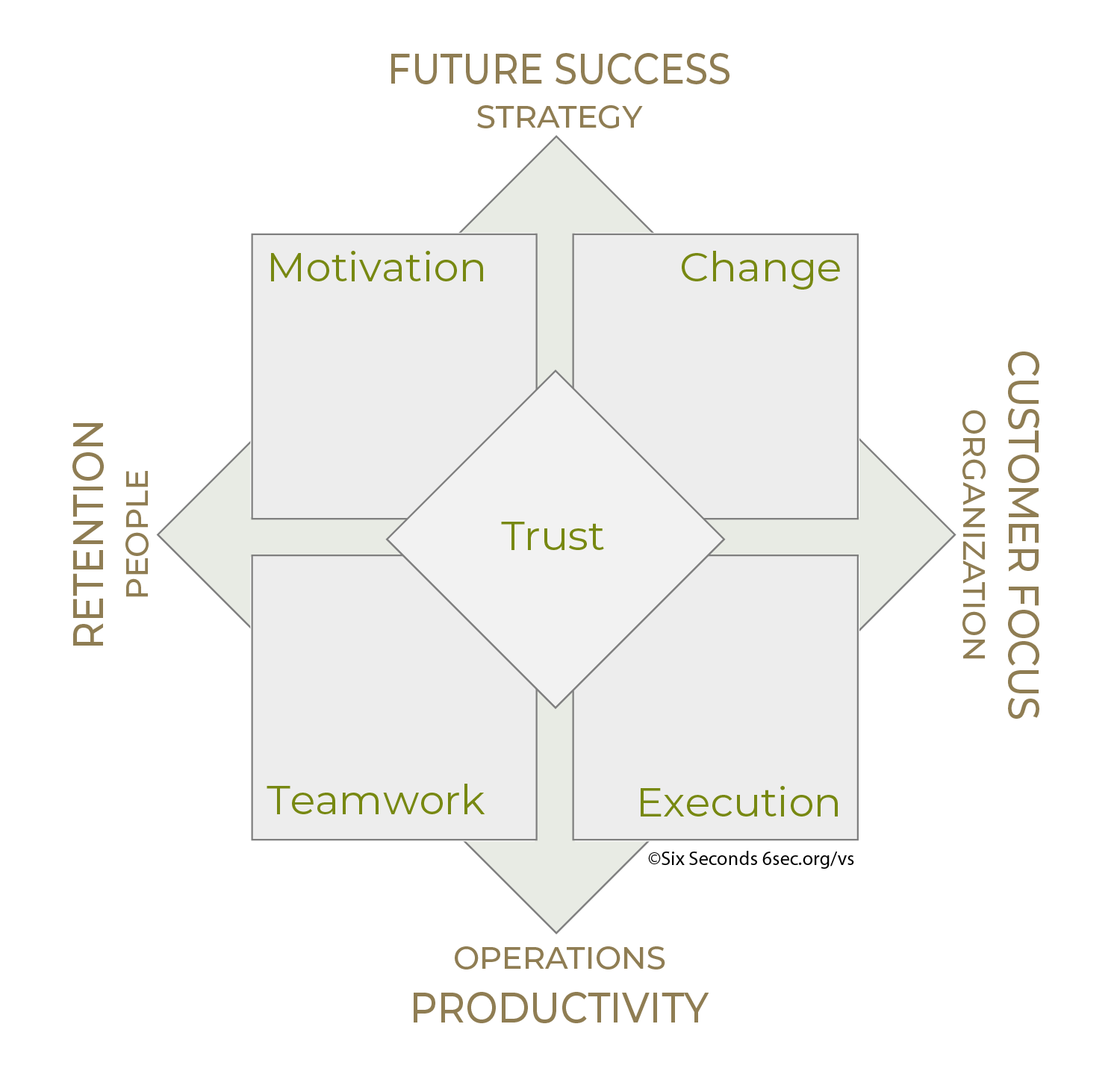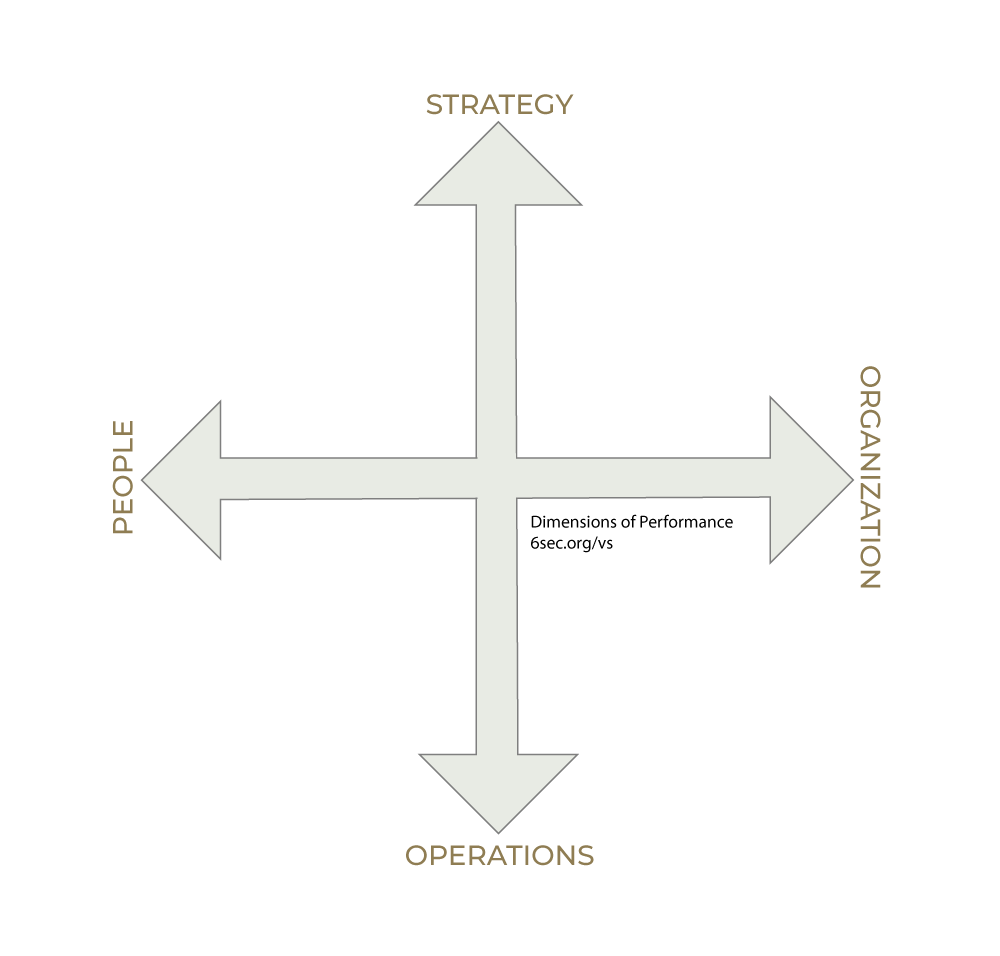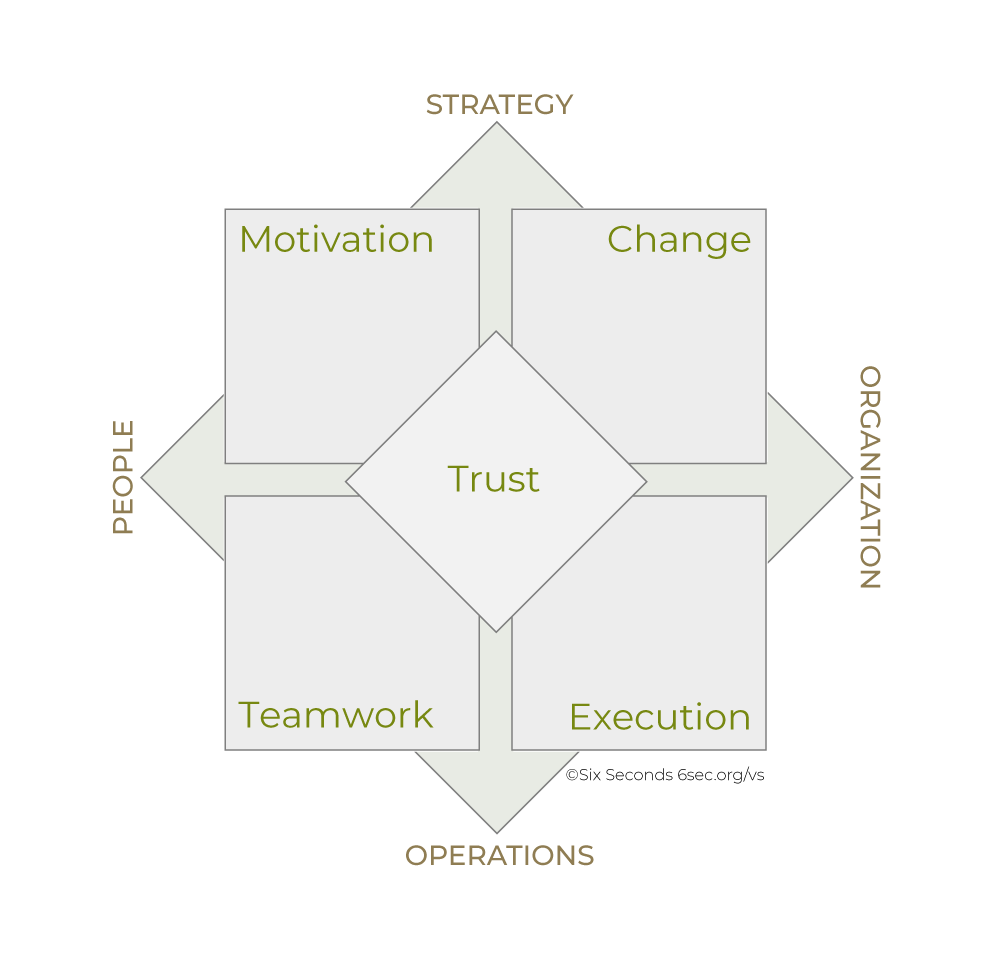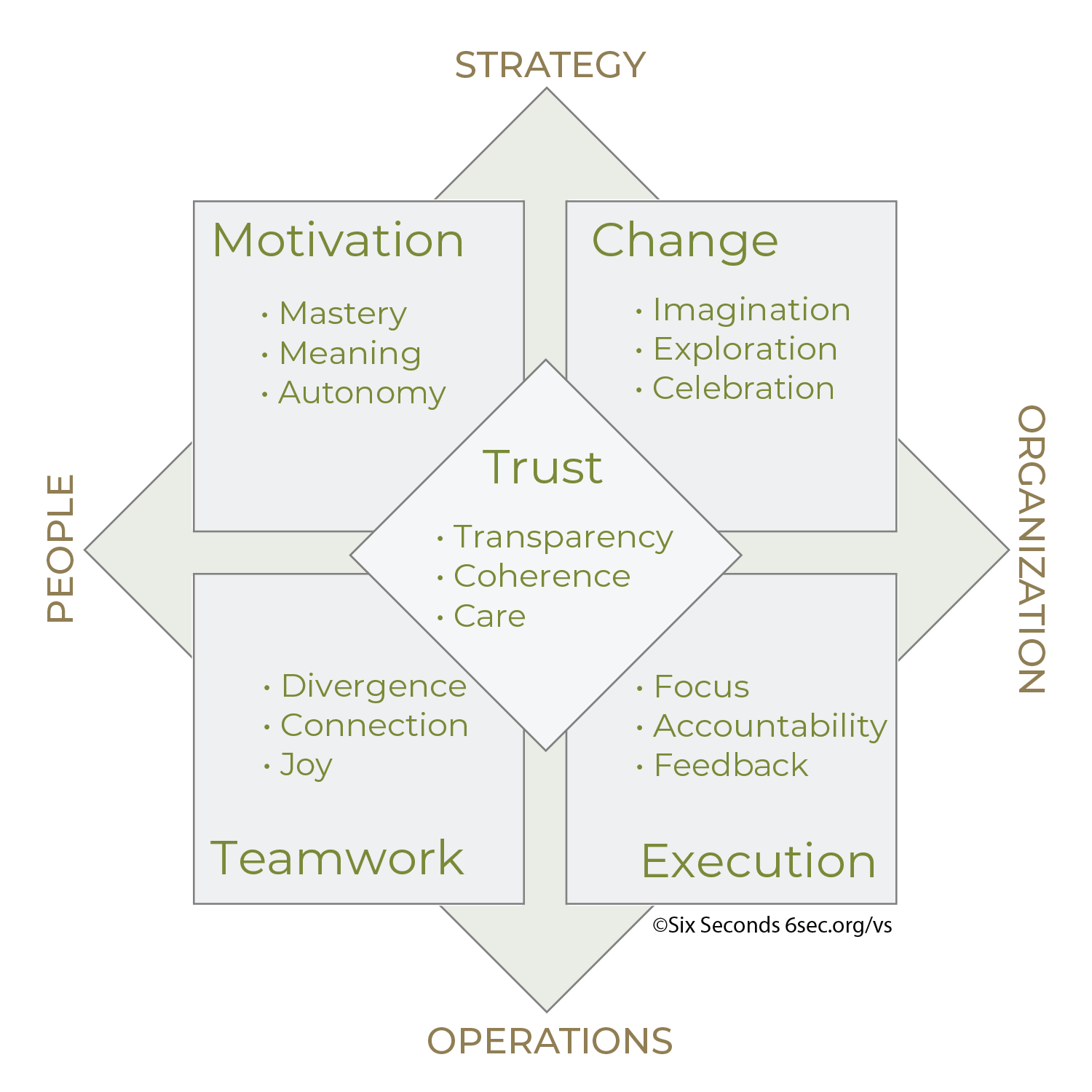What are the key drivers of organizational performance? The Vital Signs Model distills two decades of research into the actionable framework to build strong leadership, healthy teams, and vital organizations. The five drivers predict 50-60% of the variation in essential performance outcomes: Retention, Productivity, Future Success & Customer Focus.
The ‘Vital Signs’ of a High-Performing Organization
The Organizational Vital Signs model, shown to the right, includes four measurable outcomes:
Future Success: Is the organization moving in a sustainable, valuable direction?
Customer Focus: Do people perceive a commitment to genuinely care for customers in order to create loyalty?
Productivity: Are people accomplishing the work at hand and the work that matters in an efficient manner?
Retention: Is the organization holding onto talented people?
Trust, Motivation, Change, Teamwork and Execution are the five drivers that predict 50-60% of the variation in these outcomes. See definitions below.

What’s the link between Organization Culture and Climate – and why do they matter?
For decades, organizations have struggled to engage people. According to Gallup, just within the US, disengagement costs over 450 billion dollars a year. While many businesses focus on IP or market assets, at the end of the day, without strong people, organizations fail. Peter Drucker, legendary management expert, said, “Culture eats strategy for breakfast” — but how do leaders shape culture? Culture is the knowledge that determines “correct” behavior: “how we do things around here.”
Climate is a summary of how people feel about working within a particular culture. Culture is slow to change, climate is rapid. Climate is something people feel — and it’s massive driver of performance. Just consider: Do you want to come work in a place that feels toxic… and how hard will you work there?
Strong Leadership, Teams & Organizations
The Vital Signs Model applies at three levels:
How capable are leaders at building a healthy climate? This version measures leadership as building a context of trust, where people feel motivated, are adaptable to change, work together, and can be effective.
How strong are teams? The Team Vital Signs measures the work-group’s level of trust, motivation, adaptability to change, teamwork and execution.
Is this a vital organization? The Organizational Vital Signs tool measures the same five drivers across an enterprise or entity.
Driving Organizational Performance
In the “background” of the model are two axes that define performance.
To define “performance,” we tap the concept of a balanced scorecard and consider that a high performing leader, team, or organization will balance multiple dimensions.
The vertical axis goes from Strategy to Operations. Strategy is about moving toward the right long-term direction; Operations is about taking effective action today. High performance requires agility to shift between and balance the long- and short-term.
The horizontal axis shows People and Organization. This is about balancing and integrating individual and collective needs. A high performing organization supports individuals to thrive so each can fully contribute — and the shared systems and structures that create scalability.

Performance, then, means:
There is a clear direction and path to it: Strategy
That direction is put into action: Operations
There are systems to focus on customers and deliverables: Organization
Great people want to work there in a context that supports performance: People
We present these as axes because success requires the right balance depending on the needs of the situation. Sometimes leaders, teams, or organizations need to lean more in a particular direction — for example, during an intense product launch, the focus might be more on operations. However, if you’re too operationally focused for too long, you lose sight of direction. Likewise, during a reorganization, it’s critical to focus on the strategy (how you will get to where you’re going) and at the same time you need to maintain your customer focus (organization) — but you can’t forget to communicate and engage the staff (people) or the change will fail.
What Drives Performance? The Five Vital Signs
So what kind of workplace environment will allow people to achieve these results — to perform optimally? Over a decade of research with wide range of organizations, all around the world, reveals there are five drivers that account for 50-60% of the variation in those performance outcomes (read more of the research here).
A high performing team or workplace climate is grounded in trust. People have a sense of safety and assurance so they’ll take risks, share, innovate, and go beyond their own comfort zones.
People need to feel energized and committed to doing more than the minimum requirement: Motivation.
They need to be adaptable and innovative: Change.
They need to feel collaboration and communicate to take on the challenges: Teamwork.
They need to be focused and accountable: Execution.
As shown in the model above, Trust is the fulcrum, the center. Motivation and Teamwork are on the people side; Change and Execution are on the organization side. Motivation and Change drive strategic direction. Teamwork and Execution drive operations.

In this framework, we can say leadership is the ability to build a context of trust where people are highly motivated, adaptable to change, working as a team, and executing (achieving useful results).
An effective team has a foundation of trust with people who are highly motivated, open to change, working collaboratively, and getting important work accomplished.
A high-performing organization likewise has a context of trust where most staff are energized to put in discretionary effort, people are adaptable, they work together beyond their silos, and they are getting results.
Action Steps for Organizational Performance
To make the Vital Signs drivers actionable, we developed 15 “Pulse Points.” For example, to strengthen trust, there are three actionable points:
Transparency: Have difficult conversations about the gaps between “what we say and what we do” and don’t stonewall or pretend “everything is fine.” While, as a leader, there may be facts you’re not allowed to share with your team, it’s terrible for people to know there’s an issue and have their leader pretend it away.
Coherence: Following from the conversations above, pick one inconsistency and fix it. Make a clear, unequivocal commitment to one another and deliver. Maybe that means you set a hard stop on meetings and don’t go over. Maybe it means you, without fail, take 10 minutes on your first meeting of the week to check in. Maybe it means sending a recap of commitments. Whatever you choose, do it 100%.
Care: Frame the conversations and action plans, above, around your genuine care for one another as humans — and your care for your shared work. Even if 90% of your work is transactional and intense, fully dedicate the remaining 10% to relationship. Find the mutual common ground. Ask deeper questions. Discover what you genuinely like about one another and your work together.

Measuring the Drivers of Performance
The Vital Signs EQ for Performance Metrics are statistically validated and normed assessments based on robust international sample. This process allows for accurate comparison between scales and provides built-in benchmarks. Each of the VS tools has a different questionnaire, but all share the same model. The online questionnaires take about 10 minutes, and are scored anonymously and confidentially. There is a mix of quantitative scoring and focused narrative questions to provide context and depth to the data.
In this sample graph from Team Vital Signs, you can see the five climate drivers, which measure engagement, and the four business outcomes:

In all of the VS tools there are actually two questionnaires: The drivers and the outcomes. Statistically and empirically we know that the drivers are a major contributor to success in the outcomes, but they are measured independently.
To learn more about VS…

